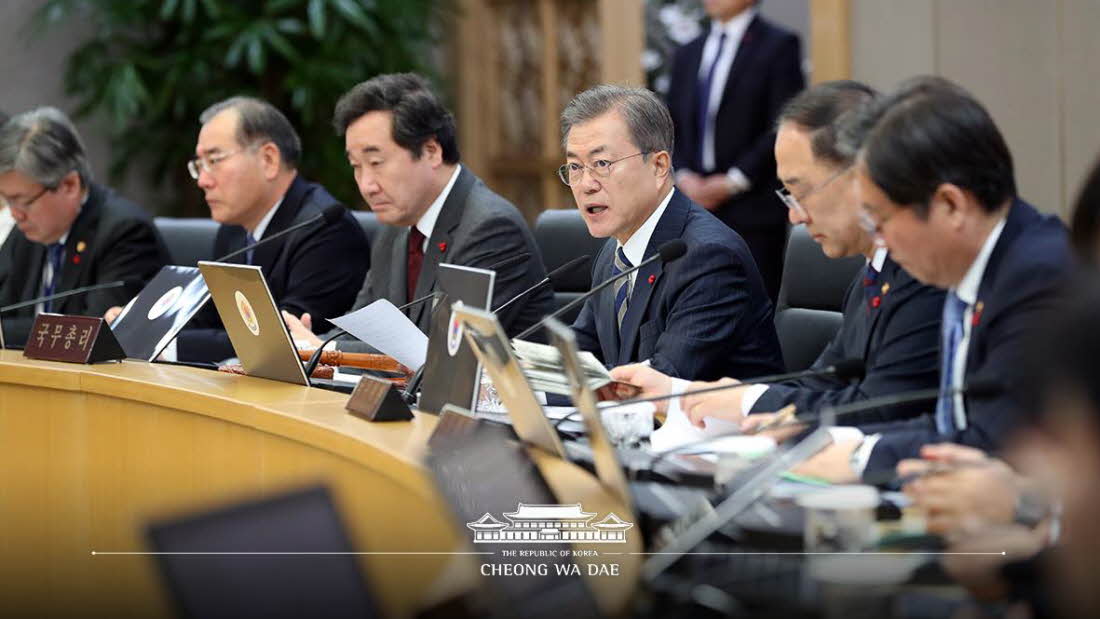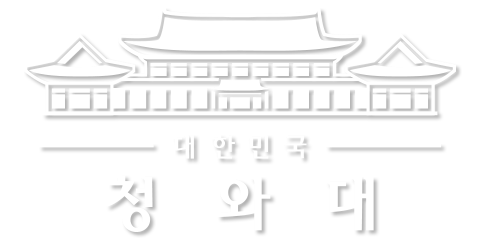이 웹사이트는 제19대 대통령 임기 종료에 따라 대통령기록관이 「대통령기록물 관리에 관한 법률」에 의해 이관받아 서비스하는 대통령기록물입니다. 자료의 열람만 가능하며 수정 · 추가 · 삭제는 불가능합니다.
다만, 「개인정보보호법」에 의하여 개인의 정보를 보호받기 원하시는 분은 관련 내용(요청자, 요청내용, 연락처, 글위치)을 대통령 웹기록물 담당자(044-211-2253)에게 요청해 주시면 신속히 검토하여 조치해 드리겠습니다. 감사합니다.
SPEECHES & REMARKS
BRIEFINGS

(Unofficial translation)
New Deputy Prime Minister for economic affairs Hong Nam-ki joins the Cabinet Meeting today for the first time since taking office. He performed well as Minister of the Office for Government Policy Coordination, and I have high expectations for him as Deputy Prime Minister, too. Former Deputy Prime Minister Kim Dong-yeon has worked hard up to now, but I hope all of you will take this transition as an opportunity to revitalize our economy by changing course and starting anew.
I urge all Cabinet members to work as one team with Deputy Prime Minister Hong so that he, as the new commander-in-chief of the economy, will be able to help bring the economy new life and dynamism.
From the macroeconomic perspective, various economic indicators can be seen as showing stability. In people’s minds, however, the economy is struggling in terms of employment and day-to-day indicators of the general public’s quality of life. The issue of the socio-economic divide and the difficulties facing microbusiness owners and the self-employed still remain unresolved. Regions in which traditional industries such as shipbuilding, automobiles and steel are in crisis are reporting more difficulties. An inclusive growth that allows everyone to prosper together will not be possible without addressing these problems. Our economic focus needs to be placed on fixing these issues.
Among other things, it is urgently needed to reinvigorate local economies to help the people feel the benefits of growth. It is no exaggeration to say that the growth plate of the Korean economy lies in local areas. This is why I have embarked on a nationwide tour to identify measures to revitalize local economies while listening to what provincial business leaders and microbusiness owners have to say.
I visited the provinces of Jeollabuk-do in October and Gyeongsangbuk-do in November. I plan to visit Gyeongsangnam-do soon. In each region, the key stakeholders from industry, academia and research institutions are putting their heads together and working on innovations to initiate new industries based on the existing industrial foundation. Efforts by local governments should be actively assisted with a focus on reviving local economies in line with the structural transformation of local industries.
In particular for its part, the Government needs to actively support projects such as building infrastructure and making local manufacturing industries more advanced and smarter and, at the same time, boldly eliminate regulations that hinder the development of new industries. I hope that the determination and bold initiatives intended to invigorate regions will originate here in Sejong City, the symbol of administration and balanced development.
New Deputy Prime Minister for economic affairs Hong Nam-ki joins the Cabinet Meeting today for the first time since taking office. He performed well as Minister of the Office for Government Policy Coordination, and I have high expectations for him as Deputy Prime Minister, too. Former Deputy Prime Minister Kim Dong-yeon has worked hard up to now, but I hope all of you will take this transition as an opportunity to revitalize our economy by changing course and starting anew.
I urge all Cabinet members to work as one team with Deputy Prime Minister Hong so that he, as the new commander-in-chief of the economy, will be able to help bring the economy new life and dynamism.
From the macroeconomic perspective, various economic indicators can be seen as showing stability. In people’s minds, however, the economy is struggling in terms of employment and day-to-day indicators of the general public’s quality of life. The issue of the socio-economic divide and the difficulties facing microbusiness owners and the self-employed still remain unresolved. Regions in which traditional industries such as shipbuilding, automobiles and steel are in crisis are reporting more difficulties. An inclusive growth that allows everyone to prosper together will not be possible without addressing these problems. Our economic focus needs to be placed on fixing these issues.
Among other things, it is urgently needed to reinvigorate local economies to help the people feel the benefits of growth. It is no exaggeration to say that the growth plate of the Korean economy lies in local areas. This is why I have embarked on a nationwide tour to identify measures to revitalize local economies while listening to what provincial business leaders and microbusiness owners have to say.
I visited the provinces of Jeollabuk-do in October and Gyeongsangbuk-do in November. I plan to visit Gyeongsangnam-do soon. In each region, the key stakeholders from industry, academia and research institutions are putting their heads together and working on innovations to initiate new industries based on the existing industrial foundation. Efforts by local governments should be actively assisted with a focus on reviving local economies in line with the structural transformation of local industries.
In particular for its part, the Government needs to actively support projects such as building infrastructure and making local manufacturing industries more advanced and smarter and, at the same time, boldly eliminate regulations that hinder the development of new industries. I hope that the determination and bold initiatives intended to invigorate regions will originate here in Sejong City, the symbol of administration and balanced development.



